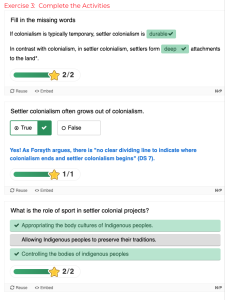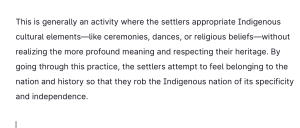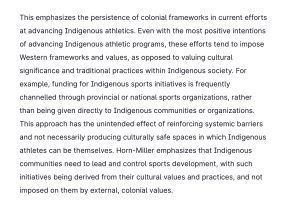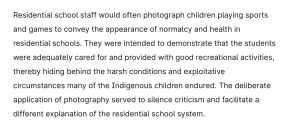4
These are difficult stories. We bear witness in this chapter to the role of sport in furthering the settler colonial projects throughout Turtle Island. Here are some supports to access in the community and from a distance:
First Peoples House of Learning Cultural Support & Counselling
Niijkiwendidaa Anishnaabekwag Services Circle (Counselling & Healing Services for Indigenous Women & their Families) – 1-800-663-2696
Nogojiwanong Friendship Centre (705) 775-0387
Peterborough Community Counselling Resource Centre: (705) 742-4258
Hope for Wellness – Indigenous help line (online chat also available) – 1-855-242-3310
LGBT Youthline: askus@youthline.ca or text (647)694-4275
National Indian Residential School Crisis Line – 1-866-925-4419
Talk4Healing (a culturally-grounded helpline for Indigenous women):1-855-5544-HEAL
Section One: History
A) The Residential School System
| I was surprised to learn that sports were used to control students. I had never considered using sports to manipulate kids into assimilation as a possibility. It was saddening since sports are meant to be fun and a way to grow socially. |
B) Keywords
Exercise 2: Notebook Prompt
Briefly define (point form is fine) one of the keywords in the padlet (may be one that you added yourself).
| Sport for Development Ideology takes the power of sports to drive social and political change. This is done by facilitating inclusivity, empowerment, and community engagement. Sports encourage diversity, teamwork and leadership. Sports are also able to address social issues like inequality and poverty. Overall, sport for development strengthens communities, enhances well-being, and equips people with skills that help them for the rest of their lives. |
C) Settler Colonialism
Exercise 3: Complete the Activities

Exercise 4: Notebook Prompt
Although we have discussed in this module how the colonial project sought to suppress Indigenous cultures, it is important to note that it also appropriates and adapts Indigenous cultures and “body movement practices” (75) as part of a larger endeavour to “make settlers Indigenous” (75).
What does this look like? (write 2 or 3 sentences)

|
D) The Colonial Archive

Exercise 5: Complete the Activities
Section Two: Reconciliation
A) Reconciliation?
Exercise 6: Activity and Notebook Prompt
Visit the story called “The Skate” for an in-depth exploration of sport in the residential school system. At the bottom of the page you will see four questions to which you may respond by tweet, facebook message, or email:
How much freedom did you have to play as a child?
What values do we learn from different sports and games?
When residential staff took photos, what impression did they try to create?
Answer one of these questions (drawing on what you have learned in section one of this module or prior reading) and record it in your Notebook.
|
|
B) Redefining Sport
B) Sport as Medicine
Exercise 7: Notebook Prompt
Make note of the many ways sport is considered medicine by the people interviewed in this video.
| -Emotionally
-Coping with trauma -Gives a sense of freedom -Unifies people -Builds identity -Builds pride -Helps see a path forward
|
C) Sport For development
Exercise 7: Notebook Prompt
What does Waneek Horn-Miller mean when she says that the government is “trying but still approaching Indigenous sport development in a very colonial way”?
 |
Exercise 8: Padlet Prompt
Add an image or brief comment reflecting some of “binding cultural symbols that constitute Canadian hockey discourse in Canada.” Record your responses in your Notebook as well.

|
Section Three: Decolonization
| Call to Action #90 focuses on the creation and maintenance of programs to support Indigenous athletes in pursuing high-level sports. Many steps have been taken to fulfill this call to action. For example, multiple organizations have sponsored and created programs in support of Indigenous athletes which allows them to attain training in sports at the highest level. They also help finance and mentor the athletes when needed. Organizations include the Aboriginal Sport Circle (ASC), Canada’s Indigenous Athlete Program, and the Indigenous Sports Circle (ISC) to name a few. Overall, these organizations help support athletes overcome barriers that wouldn’t allow them to compete. Barriers such as limited access to resources like training facilities and sponsors. Another step that has been taken is to provide scholarships in collaboration with the federal government to fund Indigenous athletes who want to pursue sports professionally. It removes financial barriers that frequently stop Indigenous athletes from even considering being an athlete. Lastly, the media has also been showing and celebrating Indigenous athletes in the mainstream. Athletes like Clifford K.T. Hume and Jesse Cockney are highlighted and shown to be role models for the Indigenous youth.
Settler communities and individuals can also have a significant impact in supporting Indigenous athletes. Supporting indigenous-led organizations, attending Indigenous sporting events, advocating for equity, promoting athletes on social media and challenging racism when seen are all significant ways to do so. To conclude, Call to Action #90 shows the need for enhanced support systems for Indigenous athletes who try to pursue sports professionally. As explained, many significant steps have been taken which have helped tremendously. |


